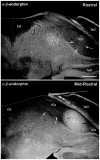Mammal-like organization of the avian midbrain central gray and a reappraisal of the intercollicular nucleus
- PMID: 21694758
- PMCID: PMC3110203
- DOI: 10.1371/journal.pone.0020720
Mammal-like organization of the avian midbrain central gray and a reappraisal of the intercollicular nucleus
Abstract
In mammals, rostrocaudal columns of the midbrain periaqueductal gray (PAG) regulate diverse behavioral and physiological functions, including sexual and fight-or-flight behavior, but homologous columns have not been identified in non-mammalian species. In contrast to mammals, in which the PAG lies ventral to the superior colliculus and surrounds the cerebral aqueduct, birds exhibit a hypertrophied tectum that is displaced laterally, and thus the midbrain central gray (CG) extends mediolaterally rather than dorsoventrally as in mammals. We therefore hypothesized that the avian CG is organized much like a folded open PAG. To address this hypothesis, we conducted immunohistochemical comparisons of the midbrains of mice and finches, as well as Fos studies of aggressive dominance, subordinance, non-social defense and sexual behavior in territorial and gregarious finch species. We obtained excellent support for our predictions based on the folded open model of the PAG and further showed that birds possess functional and anatomical zones that form longitudinal columns similar to those in mammals. However, distinguishing characteristics of the dorsal/dorsolateral PAG, such as a dense peptidergic innervation, a longitudinal column of neuronal nitric oxide synthase neurons, and aggression-induced Fos responses, do not lie within the classical avian CG, but in the laterally adjacent intercollicular nucleus (ICo), suggesting that much of the ICo is homologous to the dorsal PAG.
Conflict of interest statement
Figures









References
-
- Bandler R, Shipley MT. Columnar organization in the midbrain periaqueductal gray: modules for emotional expression? Trends Neurosci. 1994;17:379–389. - PubMed
-
- Behbehani MM. Functional characteristics of the midbrain periaqueductal gray. Prog Neurobiol. 1995;46:575–605. - PubMed
-
- Ruiz-Torner A, Olucha-Bordonau F, Valverde-Navarro AA, Martinez-Soriano F. The chemical architecture of the rat's periaqueductal gray based on acetylcholinesterase histochemistry: a quantitative and qualitative study. J Chem Neuroanat. 2001;21:295–312. - PubMed
-
- Sewards TV, Sewards MA. Representations of motivational drives in mesial cortex, medial thalamus, hypothalamus and midbrain. Brain Res Bull. 2003;61:25–49. - PubMed
-
- Smith GS, Savery D, Marden C, Lopez Costa JJ, Averill S, et al. Distribution of messenger RNAs encoding enkephalin, substance P, somatostatin, galanin, vasoactive intestinal polypeptide, neuropeptide Y, and calcitonin gene-related peptide in the midbrain periaqueductal grey in the rat. J Comp Neurol. 1994;350:23–40. - PubMed
Publication types
MeSH terms
Substances
Grants and funding
LinkOut - more resources
Full Text Sources

